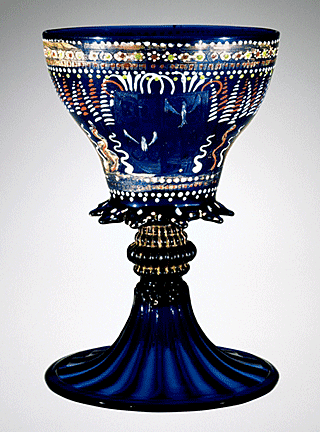 The
decorative glass industry in Europe began in Venice. The Venetians
established a highly developed industry with a vast export trade
which virtually dominated the rest of Europe until the middle of the
17th century. All subsequent development in European glass grew from
the Venetian tradition.
The
decorative glass industry in Europe began in Venice. The Venetians
established a highly developed industry with a vast export trade
which virtually dominated the rest of Europe until the middle of the
17th century. All subsequent development in European glass grew from
the Venetian tradition.
By the 13th century, Venice had become a great trading nation with a
flourishing glass industry, but Venetian glass didn’t reach its peak
until the first half of the 16th century.
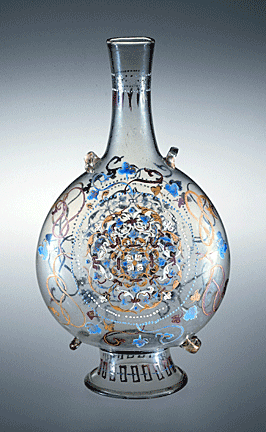 Venetian,
like Roman, glass was a light and thin-walled soda glass, made from
raw materials obtained by the Venetians through their trade. It
consisted of soda ash, imported either from Spain or Egypt, and
white pebbles from the Po or the Ticino Rivers together with lime in
the form of powdered marble or crushed sea shells to give this very
delicate substance added stability. By the end of the 10th century
there were glassworkers in Venice making simple glass objects such
as bottles and flasks, possibly with the help of craftsmen from
Byzantium or Syria where there were well-established glass
industries at this time.
Venetian,
like Roman, glass was a light and thin-walled soda glass, made from
raw materials obtained by the Venetians through their trade. It
consisted of soda ash, imported either from Spain or Egypt, and
white pebbles from the Po or the Ticino Rivers together with lime in
the form of powdered marble or crushed sea shells to give this very
delicate substance added stability. By the end of the 10th century
there were glassworkers in Venice making simple glass objects such
as bottles and flasks, possibly with the help of craftsmen from
Byzantium or Syria where there were well-established glass
industries at this time.
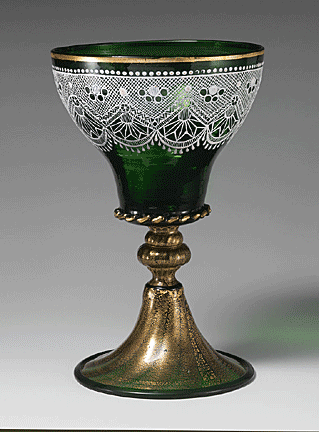 During
the 13th century, the glass industry became a monopoly in the
Venetian Republic. In 1292, glassmakers established factories on the
island of Murano to avoid the risk of fire in Venice, itself. At
that time, glasshouses by law had to be no less than 15 paces from
any building. The law also rigidly controlled the establishment of
glasshouses elsewhere. Venetian glassworkers originally belonged to
a guild system and were virtually prisoners of the state with very
restricted freedom of movement. They were forbidden to emigrate from
Venice on pain of death. The export of glassing materials and of
cullet, or broken glass, was also forbidden so as to keep
glassmaking within the Republic. However, by the 16th and 17th
centuries there were glasshouses based on the Venetian pattern had
been established elsewhere in Europe.
During
the 13th century, the glass industry became a monopoly in the
Venetian Republic. In 1292, glassmakers established factories on the
island of Murano to avoid the risk of fire in Venice, itself. At
that time, glasshouses by law had to be no less than 15 paces from
any building. The law also rigidly controlled the establishment of
glasshouses elsewhere. Venetian glassworkers originally belonged to
a guild system and were virtually prisoners of the state with very
restricted freedom of movement. They were forbidden to emigrate from
Venice on pain of death. The export of glassing materials and of
cullet, or broken glass, was also forbidden so as to keep
glassmaking within the Republic. However, by the 16th and 17th
centuries there were glasshouses based on the Venetian pattern had
been established elsewhere in Europe.
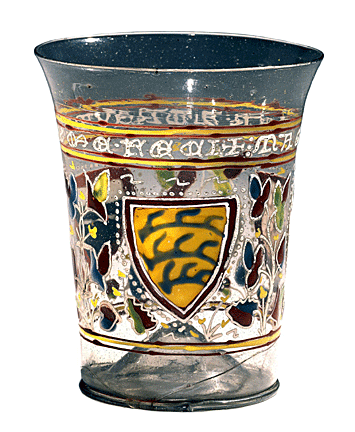 By
the 14th century, Venetian glassmakers weren’t allowed to leave the
Republic. Anyone caught exporting professional glassmaking secrets
was put to death. Many craftsmen took this risk and set up glass
furnaces in surrounding cities and as far afield as England and the
Netherlands. By the end of the 16th century, 3,000 of Murano
island's 7,000 residents were involved in some way in the
glassmaking industry.
By
the 14th century, Venetian glassmakers weren’t allowed to leave the
Republic. Anyone caught exporting professional glassmaking secrets
was put to death. Many craftsmen took this risk and set up glass
furnaces in surrounding cities and as far afield as England and the
Netherlands. By the end of the 16th century, 3,000 of Murano
island's 7,000 residents were involved in some way in the
glassmaking industry.
Early Venetian glass was simple—jugs, carafes and bottles—but in the
15th century, with the great impetus of the Renaissance, glass
became one of the most elaborate art forms of the period. It wasn’t
only brilliant in color but also elaborately decorated. Venetian
glassworkers could produce blue, green, purple and opaque white
glass. Some of the glass to imitate semi-precious stones, such as
onyx, agate and chalcedony.
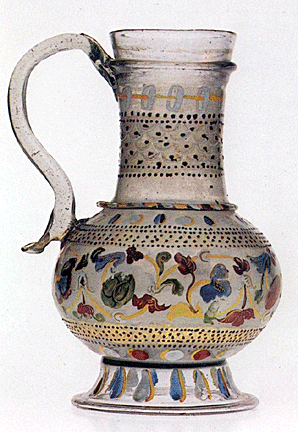 Enameling
on glass first appeared in Venice in the mid-15th century.
Glassmakers created objects with dark backgrounds of colored glass
to display the beauty of the enamel decoration, which they painted
in fusible enamel and fired by baking in a small oven. This was an
Islamic technique of the 13th and 14th centuries, but it probably
developed independently in Venice from the use of enamel on
metalwork. The decoration on enameled glass had similarities with
contemporary Renaissance decorative motifs. Artisans used it not
only in a pictorial fashion but also in colored spots of enamel,
giving a gem-like effect comparable with the decoration on
contemporary goldsmiths' work. Venetian glassmakers primarily used
enameling, in its pictorial form, for the decoration of goblets and
chalices, often commissioned to commemorate a betrothal or a
marriage.
Enameling
on glass first appeared in Venice in the mid-15th century.
Glassmakers created objects with dark backgrounds of colored glass
to display the beauty of the enamel decoration, which they painted
in fusible enamel and fired by baking in a small oven. This was an
Islamic technique of the 13th and 14th centuries, but it probably
developed independently in Venice from the use of enamel on
metalwork. The decoration on enameled glass had similarities with
contemporary Renaissance decorative motifs. Artisans used it not
only in a pictorial fashion but also in colored spots of enamel,
giving a gem-like effect comparable with the decoration on
contemporary goldsmiths' work. Venetian glassmakers primarily used
enameling, in its pictorial form, for the decoration of goblets and
chalices, often commissioned to commemorate a betrothal or a
marriage.
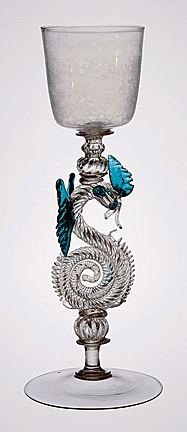 It
was in the 16th century that the Venetian glass industry reached its
peak. There was enormous prosperity and the export of glass from
Venice dominated Europe. Glass became not only a highly desirable
luxury, but also a great status symbo. Glassmakers sent their finest
pieces to the princely courts and rich merchants' houses of Europe.
Connoisseurs collected a great number of the pieces, using them as
display objects to flaunt their wealth.
It
was in the 16th century that the Venetian glass industry reached its
peak. There was enormous prosperity and the export of glass from
Venice dominated Europe. Glass became not only a highly desirable
luxury, but also a great status symbo. Glassmakers sent their finest
pieces to the princely courts and rich merchants' houses of Europe.
Connoisseurs collected a great number of the pieces, using them as
display objects to flaunt their wealth.
Venetian glass of the 16th century was fanciful and fantastic, much
lighter in design and far less massive in shape and size than glass
of the 15th century. Glassmakers blew the glass more thinly.
Glassmakers invented a glass similar in appearance to rock crystal,
called cristallo, which became an instant success. Refined by the
use of manganese, cristallo was the most famous glass made in
:Venice. It could not, by law, be sold by pedlars or stall-holders.
Glassmakers used little surface decoration and colored glass at this
time. Instead, they applied the enamel decoration onto a clear
ground, mostly for the export market.
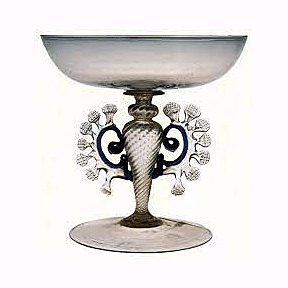 Venetian
cristallo was so fragile that it couldn’t be refired for decorative
purposes because of the risk of distortion. In the 16th century,
glassmakers put a greater emphasis on elaborate shapes and
decorative borders, stems and handles, applied to the glass itself.
The only other form of decoration they used was diamond-point
engraving-–never very popular in Venice and rarely figurative, as in
English glass of the time. Cristallo was used to great effect to
create fantastic and elaborate articles, such as the magnificent
nefs, or boat-shaped ewers, which graced the tables of renaissance
Europe. Objects such as these were highly desirable, not only for
their beauty, but also for their originality and for their air of
fantasy which is very much in keeping with contemporary design.
Venetian
cristallo was so fragile that it couldn’t be refired for decorative
purposes because of the risk of distortion. In the 16th century,
glassmakers put a greater emphasis on elaborate shapes and
decorative borders, stems and handles, applied to the glass itself.
The only other form of decoration they used was diamond-point
engraving-–never very popular in Venice and rarely figurative, as in
English glass of the time. Cristallo was used to great effect to
create fantastic and elaborate articles, such as the magnificent
nefs, or boat-shaped ewers, which graced the tables of renaissance
Europe. Objects such as these were highly desirable, not only for
their beauty, but also for their originality and for their air of
fantasy which is very much in keeping with contemporary design.
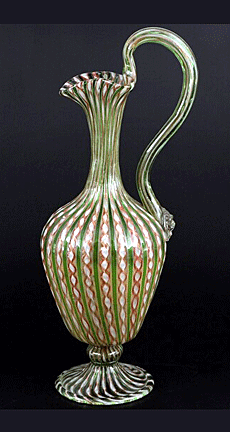 The
Venetians also produced latticinio, a reticulated, filigree, or
lace-glass, first mentioned in its most elaborate form in 1540. This
glass incorporated an opaque or colored glass thread in a
complicated and difficult process. In its most complex form as
lace-glass, it produced elaborate objects for display. Another
elaborate form of glass which appears in 16th-century Venice was
ice-glass, also known as crackle glass.
The
Venetians also produced latticinio, a reticulated, filigree, or
lace-glass, first mentioned in its most elaborate form in 1540. This
glass incorporated an opaque or colored glass thread in a
complicated and difficult process. In its most complex form as
lace-glass, it produced elaborate objects for display. Another
elaborate form of glass which appears in 16th-century Venice was
ice-glass, also known as crackle glass.
By the end of the 15th century, Venice’s glass industry was
beginning to decline.
Throughout the 16th century Venetian domination was constantly being
eroded by the proliferation of glasshouses in Eastern Europe and
Asia making Venetian-inspired glass. Plus, public tastes had changed
while the designs made on Murano had mostly stayed the same and the
low wages paid to glassworkers caused many to seek employment
elsewhere.
